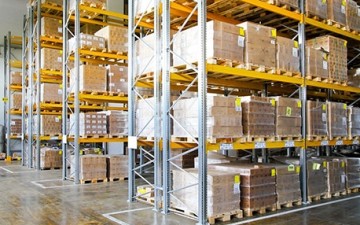Materials Management – Definition, Benefits, Best Practices
Implementing proper materials management practices allows businesses to make sure the correct materials with the best price and quality reach the shop floor at the right time and in the correct quantity. Follow these best practices to get more control over this essential segment of the supply chain.

You can also listen to this article:
What is materials management?
Materials management refers to the strategic planning, coordination, and control of all activities involved in the procurement, storage, handling, and utilization of materials within a manufacturing organization. The process is aimed at managing the quality, sourcing, and price of materials, as well as their location and movement within the manufacturing pipeline.
The goal of materials management is to ensure that the right materials are available in the right quantities, at the right time, and in the right condition, while minimizing costs and optimizing efficiency. The job of the materials manager is to achieve this goal by ensuring close coordination between inventory, procurement, and production, and setting up procedures for communicating material requirements and distributing raw materials down the supply chain.
While some organizations may consider materials management a subsection of overall procurement management, other companies treat them as separate entities that serve different areas of a business. Others still may divide the functions of materials management between many business departments like procurements, supply chain, logistics, etc. This is often the case for larger manufacturing or construction enterprises.
As part of procurement management, materials management includes everything related to the sourcing and purchasing of materials. However, if treated as a separate subsection of supply chain management, it becomes a link between procurement and production, dealing mostly with material requirements planning, coordinating material deployment and replenishment, and conducting quality control and inventory analysis for direct materials.
It is worth mentioning that the materials used in manufacturing are usually divided into direct and indirect materials. Direct materials are the raw materials that are used in the products a company produces: rubber in tires, sugar in soda, etc. Indirect materials are items and materials used in the manufacturing process that do not make up the product itself. These may include adhesives, staples, equipment, or spare parts. In most cases, materials management includes controlling the flow of both.
What is Sustainable Materials Management (SMM)?
Sustainable Materials Management (SMM) is an approach to promoting resource and energy efficiency that considers the entire lifecycle of a product or material. This includes the design, manufacture, use, and management of products and materials, as well as solid waste management, in a way that minimizes their impacts on the environment, conserves resources, and reduces waste.
The SMM approach, as defined by the U.S. Environmental Protection Agency (EPA), is based on the principle that our economic well-being and environmental health are intrinsically linked. It seeks to:
- Use materials wisely, reducing the amount and toxicity of waste we generate.
- Conserve resources and minimize the environmental impacts associated with the materials we use.
- Promote innovative products and processes that can significantly reduce environmental impacts.
SMM involves a change in how a society views and uses materials, transitioning from a linear model of ‘take-make-waste’ to a more circular model where materials are reused, recycled, or composted at their end of life. The ultimate goal of SMM is to ensure that material use contributes to the sustainable future of our planet, promoting not just environmental health, but also economic prosperity and social wellbeing.
Benefits of materials management
Implementing effective materials management processes comes with an array of benefits that could reverberate throughout your operation.
- Streamlined procurement. Materials management ensures the procurement of the right materials in the right amount, which allows companies to streamline procurement processes and eliminate excess costs. Precise procurement prevents wastage and can result in significant savings.
- Efficient inventory control. One of the key aspects of materials management is maintaining optimal inventory levels. This can prevent both overstocking and shortages, reducing the costs related to unnecessary storage or rush ordering, leading to overall cost-effectiveness.
- Effective warehousing: Proper organization and control of warehousing operations lead to better space utilization and reduced costs. Materials management plays a key role in achieving this operational efficiency.
- Accurate production schedules. Effective materials management enables precise planning and execution of production schedules. By accurately forecasting the demand for and availability of materials, businesses can ensure that production processes run smoothly and without interruption. This on-time production not only reduces downtime but also boosts overall operational efficiency and customer satisfaction, as on-time deliveries become the rule rather than an exception.
- Promotion of sustainability. With the concept of Sustainable Materials Management, organizations can reduce environmental impacts and conserve natural resources. This life-cycle approach promotes resource efficiency and contributes to corporate social responsibility initiatives.
- Enhanced quality control. Rigorous material management processes can help ensure the quality of materials used in the production process. This not only improves the manufacturing process but also enhances the final product quality, leading to better customer satisfaction.
- Reduced waste. By adopting the principles of the circular economy and effective waste management, materials management can contribute to reducing solid waste. It maximizes the use and reuse of resources, which is not just cost-effective but also helps in conserving natural resources.
In conclusion, materials management, when executed properly, can provide economic, operational, and environmental benefits. It ensures efficiency and sustainability in the use of materials, aids in meeting customer demand effectively, and plays a crucial role in the performance of any manufacturing company.
Materials management best practices
Effective materials management involves several best practices that can significantly enhance operational efficiency and sustainability. Here are some key best practices:
Set standards for material specifications and quality
The materials manager is the ultimate decision-maker when it comes to quality control and approving raw materials for purchasing. However, the materials manager cannot be at the helm of every purchasing process and every quality check, so they need to set standard operating procedures to be followed by those participating in the process. That includes putting material specifications as well as quality and sourcing requirements in place. This is the basis for maximizing product conformity and minimizing non-conformity.
Conduct regular quality checks and evaluate supplier performance
Effective quality control starts before the production process. Of course, no company is capable of assessing the quality of every unit of raw materials they receive, but quality control checks should be done on a regular basis, as often and as thoroughly as financially viable. In most cases, failures due to bad quality (especially internal failures, i.e. those detected by the customer, the ones necessitating returns, repairs, etc.) are more expensive than measures taken to ensure good quality. Partner with suppliers that can reliably provide the right materials, in the right amounts, at the right time. Evaluate suppliers based on factors such as cost, quality, reliability, and sustainability practices.
Read more about Supplier Performance Management.
Know the exact amount and location of your direct/raw materials
In order to provide the factory floor with the needed materials at the right time, you will have to know where and in which quantity the materials are. Correct markings and good warehouse organization are imperative in every company dealing with physical inventory. Physical counts should be conducted periodically to detect inconsistencies or misplacements, but technological solutions such as inventory management software or MRP software should be used to account for inventory in the day-to-day.
Keep track of your direct/raw materials inventory costs
A substantial portion of the average manufacturer’s expenses comes from direct material costs. Therefore, it is absolutely essential to make sure that excess inventory is not tying up cash that could be put into good use elsewhere. Furthermore, holding inventory for too long could result in perished or damaged goods. This is especially true in the case of materials that have an expiry date. Manufacturers should consider different inventory valuation methods (e.g. FIFO, LIFO, Weighted Average) according to the nature of their business.
Create a plan and follow it
Material planning is a vital part of materials management. After demand planning, i.e. predicting the product quantities you will sell during a set period, you can use the bills of materials of your products to calculate your material requirements for the period. Then, looking at the material quantities you already have available in stock, you can determine the amount of materials you have to order and create a material delivery schedule to make sure that raw materials are constantly fed into production and work would not stop because of a material stockout.
Use inventory control techniques
Using proven inventory control techniques might give you better insight into the performance of your SKUs and provide you with the knowledge that would help you minimize your inventory costs.
ABC (+XYZ) analysis
By applying the Pareto principle (or 80/20 rule) to inventory management, ABC analysis allows you to prioritize your SKUs according to their consumption value. Conducting an ABC analysis will divide your materials into three categories:
– A for about 20% of the total SKUs that make up about 80% of the total consumption value. These items will receive the most attention: higher service levels, more review time, etc.
– B for about 30% of the SKUs making up around 15% of the total consumption value. These will receive less attention than A-category items and more attention than C-category items.
– C for about 50% of the SKUs that make up only 5% of the total consumption value. These will have the least amount of resources allocated to them.
In case only one parameter proves to be too basic in prioritizing your items, adding XYZ analysis into the mix also lets you account for fluctuations in the consumption patterns of the SKUs.
Read more from this article about ABC and XYZ Analysis.
Safety Stock and Reorder Point
Safety stock is the buffer of materials you hold to avoid stock-outs and continue production in case irregularities occur in the supply chain due to shifting supply or demand.
The reorder point is the set level of inventory at which an order for an SKU is triggered when it is time to replenish its stock.
Having only a reorder point set means that when delivery times exceed the expected time to a stock-out, your materials will be exhausted and production will stop until new materials arrive. However, having a safety stock will prevent that from happening as well. Both of these values need to be mathematically defined, however, in order to ensure that they provide the most value to your business.
You can find out more about these techniques from our blog posts about Safety Stock and Reorder Point.
Just in Time
Just in Time is not just an inventory control method but also a general approach to manufacturing that aims to minimize the time a product spends in the supply chain – from the supplier of the materials to the end consumer. This way, manufacturers can avoid overproduction, reduce bottlenecks and waiting time in production processes, and avoid holding excess inventory.
When talking about materials management, the general idea of JIT is to provide materials as they are needed, as closely according to demand as possible. As a consequence, the movement of materials is streamlined while inventory levels along with holding space and costs are drastically reduced.
Read more about Just in Time Manufacturing.
Minimize search time by using material kitting
Material kitting means bundling the components of a BOM into a ready-to-consume set before arriving on the production floor. This technique simplifies line-side inventory and improves picking speed, reporting, and quality control processes.
As a general rule, the practice of kitting would be most beneficial when dealing with large varieties of small components, customized products with different variables, or a lack of space on the shop floor that does not allow for much line-side inventory.
Read more about how to set up kitting processes.
Utilize technology to make processes more efficient
There are loads of technological solutions available that can aid manufacturers and materials managers in improving their business processes. Barcoding, RFID and IoT devices, and warehouse management software aid in managing and closely tracking your inventory. But what complements all areas of materials management along with all the other departments of a manufacturing company is a manufacturing ERP system.
A good manufacturing ERP allows manufacturers to coordinate their whole business in one single program. This includes material management processes like material requirements planning, material deployment and replenishment, supplier management, quality control, inventory control and analysis, kitting, etc.
In addition, a manufacturing ERP system streamlines other manufacturing operations management processes, including production planning and scheduling, order management, return merchandise authorization (RMA), and much more, improving management practices and efficiency across the company.
Key takeaways
- Materials management involves the strategic planning, coordination, and control of activities involved in the procurement, storage, handling, and utilization of materials. It aims to provide the right materials, in the right quantities, at the right time, and in the right condition, while minimizing costs and optimizing efficiency.
- Sustainable Materials Management (SMM) is an approach that promotes resource and energy efficiency, taking into account the entire lifecycle of a product or material.
- Effective materials management can streamline procurement, control inventory efficiently, improve warehousing operations, and maintain accurate production schedules.
- Best practices include setting standards for material specifications and quality, conducting regular quality checks and supplier performance evaluations, keeping track of direct/raw materials inventory and its costs, and having a comprehensive material plan.
- Inventory management software or MRP/ERP software can assist in tracking, organizing, and planning for inventory, thereby increasing material management efficiency.
Frequently asked questions
An example of materials management is a car manufacturer organizing the procurement, storage, and usage of specific raw materials like steel, rubber, and glass, ensuring they are available in the right quantities and at the right time to produce a particular model of a car. They might use manufacturing ERP software to accurately forecast demand, manage inventory levels, and schedule procurement, ensuring a smooth production process.
Supply Chain Management (SCM) involves managing the entire flow of goods and services, from raw materials procurement to delivering final products to customers. Operations Management (OM) oversees the day-to-day production processes within a company, focusing on the efficiency and effectiveness of operations. Materials Management (MM), on the other hand, specifically handles the sourcing, acquisition, storage, and allocation of materials required in the production process.
Yes, materials management is a part of logistics as it involves the storage, control, and movement of materials within and from an organization, which are crucial aspects of the logistics process.
You may also like: Material Planning – Definition, Tools, and Tips




